Anne McComish Myths and Reality: Mosaics from the Vatican Studio, 1900-32 The Vatican Mosaic Studio has been producing mosaic artworks of the highest quality since 1727. Some of its finest works take pride of place in the decorative-arts collections of the world’s major galleries, while others are regularly offered for sale by the world’s leading auction houses. Naturally, the finest works are the most valuable, and it is frequently also assumed that the finest works are necessarily the oldest. However, are all of the works on display or offered for sale as old as their gallery labels or sales catalogues suggest? And how many of them are from the Vatican Mosaic Studio at all? Attribution and dating are among the most challenging tasks for any art historian but in the case of mosaics from the Vatican Mosaic Studio the task…
Tag: 19th century art
NGV Lecture | Monet and Rodin: Separate Artists, Similar Paths, Laurie Benson
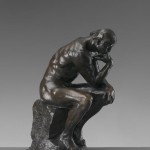
Monet and Rodin: Separate Artists, Similar Paths Laurie Benson, Curator, International Art This lecture is presented in association with the 2013 Melbourne Winter Masterpieces exhibition Monet’s Garden: The Musée Marmottan Monet, Paris. Born within two days of one another and ultimately achieving success, fame and recognition, both artists trod intriguing and very bumpy paths to attain their status in the art world. They were both revolutionaries who transformed art in their respective media. They were also good friends and they exhibited together in a landmark joint show in 1889. This talk will explore the synergies between these two giants of French art, and keen gardeners. The Annual Duldig Lecture on Sculpture commemorates the life and work of the internationally recognised sculptor Karl Duldig and the artist and inventor Slawa Duldig (née Horowitz). Date: 6pm, Monday 12 August Venue: Clemenger BBDO…
Short Course | The Age of Impressionism – France & Australia | Monet’s Garden
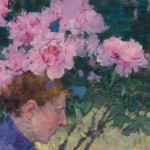
Presented by art and cultural historians this series of lectures will delve into the social and cultural world of the Impressionist era in Paris and will address how the Australian artists connected with their international contemporaries. In conjunction with Australian Impressionists in France exhibition. Sat 3 Aug, 2pm From the Gare Saint Lazare to Giverny We will trace Claude Monet’s artistic and personal journey as he moved ever further from Paris via Argenteuil, Vetheuil to Giverny and became increasingly engrossed in the study of landscape and light. Speaker: Sylvia Sagona, Fellow, The University of Melbourne Sat 10 Aug, 2pm The word and the image Emile Zola, art critic and champion of the Impressionists, wrote a series of now famous novels on the districts of Paris represented in their canvasses, using a literary style inspired by their ideas and techniques.…
Reflections on Monet | Floor talks at the NGV
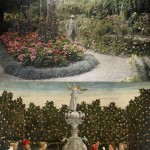
During July the NGV is presenting a series of floor talks that will link the permanent collection with the current exhibition Monet’s Garden. Join experts in various fields as they explore the NGV collection, making connections with Monet’s life, work and the Impressionist era. Please note these talks will not take place in the Monet’s Garden exhibition. Free Entry. Meet at the Information Desk on the ground Floor of NGV International (St Kilda Rd) Enquiries contact the NGV http://www.ngv.vic.gov.au/whats-on/programs/public-programs/floor-talk-series-the-impressionist-era Wed 3 Jul, 12.30pm | Art & Music during the Impressionist period French composers found just as much inspiration in gardens as Monet did. This floor talk explores garden-themed music from France in the late nineteenth century, exploring the works of Monet’s great contemporaries Debussy and Fauré as well as lesser-known masters such as Roger-Ducasse, D’Indy and Bruneau. Speaker John Weretka, musicologist and art…
Exhibition Review | Monet’s Garden at the National Gallery of Victoria. Reviewed by David R. Marshall

The latest NGV exhibition is, again, sourced largely from a secondary French museum (the Musée Marmottan Monet, henceforth MMM). Monet exhibitions have traditionally draw large crowds, and are much loved by gallery directors needing to feed the political machines to which they are beholden that equate numbers with success. But if ‘Monet’ is the brand of brands for art exhibitions, for organisers there is the problem of finding new ways to give a Monet show intellectual credibility and thematic coherence, while marketeers may feel the need to enrich a brand that runs the risk of becoming stale. And, given the economics of international exhibitions in Australia, the bulk of the works need to come from a single source. Hence Monet’s Garden.
‘Monet’s Garden’ is an idea rich in possibilities: it connects cultural tourism (a trip to Giverny) with high-art glorification of artistic genius. While previous NGV exhibitions have emphasised, through videos, places associated with the objects on display (notably the Musée Moreau in the Moreau exhibition and Malmaison with Napoleon), Monet’s Garden takes the place/artwork nexus one step further. I once taught a subject in art history on the history of gardens called Visions of Paradise: Art of the Garden, a title stolen from a picture book by Marina Schinz, and did a week on Monet and Giverny. One of the essay questions was whether Monet was a better gardener than painter. This generated some interesting responses. By asking this question one is forced to look at his Giverny paintings differently: as topographical painting, subordinate to the place represented, rather than a this-is-a-work-of-genius painting. It is quite intriguing, after studying the now well-known colour photos of Monet in his garden nearest the house (e.g. pp. xxiv-xxv of the catalogue) (Fig. 1), to be able to identity what the paintings actually represent. The strength of Impressionism was that it accepted the facts and went from there, so that its underpinning of visual factuality is there if you choose to look. A visit to the waterlily pond at Giverny makes you realise that his Nymphéas paintings are much more realistic than you had thought when you saw them in a gallery (Figs. 3, 14). This helps us to see Monet differently: as the last of the estate topographers, rather than as a wannabee modernist abstractionist.
Symposium | Impressions of Monet
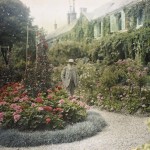
Impressions of Monet | Monet’s Garden To celebrate the most extensive exhibition of Monet’s work ever to travel to Australia the NGV is holding a symposium with local and international experts that will explore key themes of the exhibition. The symposium is generously supported by the Australian International Cultural Foundation, an affiliate of Art Exhibitions Australia. Program Tony Ellwood, Director, NGV | Welcome Colta Ives, Curator Emerita, The Metropolitan Museum of Art, New York | Monet: Impressionist in the garden Marianne Mathieu, Assistant Director and Curator, Musée Marmottan Monet | Impressionism at the Marmottan Sophie Matthiesson, Curator, International Art, NGV | Monet’s political garden Prof Emerita Virginia Spate, University of Sydney | Paint and water Dr Matthew Martin, Assistant Curator, International Decorative Arts and Antiquities, NGV | Inside Monet’s house at Giverny Date: Saturday 11th May, 1:30-5pm Venue: BBDO Clemenger Auditorium,…
Lecture | ‘Broken Pastoral and the English Folk’ Professor Tim Barringer
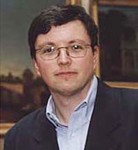
‘Broken Pastoral and the English Folk’ Professor Tim Barringer, Paul Mellon Professor of Art History, Yale University This paper examines the revived interest in folk culture in late-Victorian and Edwardian Britain, exploring the relationships between ethnography, musicology and the study of historical arts and crafts. It places within this matrix the work of photographers, painters and composers, who derived both motifs and models for avant-garde artistic identity from the study of the rural poor. Professor Tim Barringer contends that the aesthetic potency of visual and musical compositions drawing on folk sources lay in the widespread acknowledgement of the imminent disappearance of folk culture in the face of modernity and mechanized warfare. Under consideration are the photographer P.H. Emerson, painters George Clausen, Henry Herbert La Thangue and Augustus John, the gardener and writer Gertrude Jekyll, ethnographer E.B. Tylor, and composers Sir Hubert…
Floor Talks for Radiance: The Neo-Impressionists

The NGV is holding a series of 30 minute lunchtime floor talks on the art of the Neo-Impressionists and the cultural life of the period as part of its programs for the exhibition Radiance: The Neo-Impressionists. Program Thursday 6th December, 12.30pm: Music in the Age of Neo-Impressionism Speaker John Weretka, musicologist and art historian John Weretka holds qualifications in musicology, history, art history and theology, and is a PhD student in the Faculty of Architecture, Building and Planning at the University of Melbourne. His PhD study investigates the Roman church facade between the death of Borromini and the construction of the facade of the Lateran in 1732. He has taught counterpoint and harmony and the history of music in the Renaissance for the University of Melbourne. Author of articles on the depiction of musical instruments in the paintings of Watteau,…
Exhibition Review | Sydney Long: The Spirit of the Land. Reviewed by Caroline Jordan.
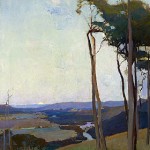
Sydney Long: The Spirit of the Land Reviewed by Caroline Jordan Only at the National Gallery of Australia, 17 August—11 November, 2012, with a catalogue by Anne Gray and Roger Butler. Exhibition is closed but the website and image galleries are still available on the NGA website here. Sydney Long is one of the painters I like to visit when I go to Sydney. The AGNSW holds some of his iconic works: the pale-skinned boys river bathing in By Tranquil Waters (1894) (Fig. 1), the nymphs and satyrs gambolling in the Austral twilight in Pan (1898) (Fig. 2), an Aboriginal maiden playing a pipe to a flock of magpies in The Music Lesson (1904) (Fig. 3), and the swirling decorative panel Fantasy (Fig. 4). Add to this Brisbane’s blithe nymph leading on a flock of brolgas in Spirit of the Plains…
Exhibition Review | Radiance: The Neo-Impressionists. Reviewed by David R. Marshall
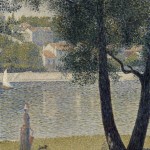
Radiance. The Neo-Impressionists Reviewed by David R. Marshall Radiance: The Neo-Impressionists. National Gallery of Victoria, 16 November 2020 – 17 March 2021 Impressionism was killed by theory, the theory that gave the Neo-impressionists their identity. Neo-Impressionist theory picked up on Impressionism’s naturalism and acute observation of outdoor light effects (coloured shadows and so forth) and married them to contemporary colour theory. The result was a pseudo-scientific artistic practice that proved to have interesting artistic possibilities wholly at odds with the theory that underpinned it. The science was the idea of optical mixing of colours and the theory of complementary contrasts. These were set out by in a book published forty years earlier by Michele-Eugène Chevreul, who had been director of the Gobelins tapestry works. Optical mixing derived from the practice of tapestry workers of twisting differently coloured threads together to…
Symposium | Colonial Art Exhibitions: Past, Present Future
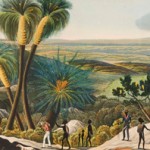
Colonial Art Exhibitions: Past, Present Future The last decade has witnessed a resurgence of interest in Australian colonial art, with an unprecedented number of important exhibitions being held in our major art galleries (national, state and regional) and libraries. This symposium brings together many of Australia’s leading directors, senior librarians, curators, conservators and academics to discuss the past, present and future interpretation of colonial art in this country. Speakers include John McPhee, Julie Gough, Gordon Morrison, Jane Hylton, David Hansen, Ruth Pullin, Richard Neville, John Jones, Lisa Slade, Simon Gregg, Alisa Bunbury, Chris McAuliffe, and many others. Full program is available here (pdf) Date: Friday, 23 (9am-8pm) – Saturday 24th (1oam-4:15pm) November 2012 Venues: Session 1 – 23rd Nov, 9.00am – 5.15pm, Sunderland Theatre, Medicine (Building 181), The University of Melbourne Session 2 – 23rd Nov, 6.15 – 8.00 pm, Theatre A,…
Lecture and Floortalk | ‘The Neo-Impressionists’
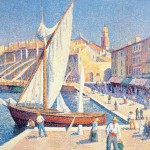
The Neo-Impressionists Lecture by Marina Ferreti Bocquillon and floortalk by Anthea Callen Lecture | Enjoy this exclusive opportunity to hear insights by the international guest curator of the exhibition Radiance: The Neo-Impressionists, Marina Ferretti Bocquillon Director scientifique, Musée des impressionisms, Giverny. This lecture is presented in association with Friends of the Gallery Library. Marina Ferretti Bocquillon A specialist in the history of Impressionism and Neo-Impressionism, Marina Ferretti Bocquillon is in charge of Curatorial Direction at the Musée des Impressionnismes (Museum of Impressionisms) in Giverny and also manager of the Signac Archives. She has published numerous essays and books, including Signac aquarelliste [Signac: Watercolours] (Adam Biro, 2001), L’Impressionnisme (Que sais-je, 2004), and Seurat et le dessin néo-impressionniste (Cinq Continents, Musée d’Orsay, 2005). She has curated numerous exhibitions in France and abroad, notably Paul Signac 1863-1935 (Grand Palais, Vincent van Gogh Museum and…
EVCS | Angela Hesson ‘Dangerous Ornament: The Feminine Form in Art Nouveau’
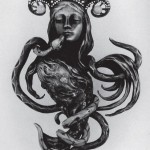
Angela Hesson Dangerous Ornament: The Feminine Form in Art Nouveau The decorative arts of the fin-de-siècle were populated by a feminized pantheon of transient, metamorphic figures and forms delicately suspended in moments of transformation. From pin trays to paper knives to poster advertisements, Art Nouveau refashioned the most controversial subjects of Decadence and Aestheticism within the most accessible and domesticated media. While the changing role of women in the literature and so-called fine art of the period has been subject to continued scholarly investigation, the decorative arts have been excluded from the majority of critical accounts, alluded to perfunctorily as reference points for nineteenth-century misogyny or female objectification. This paper will argue, by contrast, that Art Nouveau’s celebration of the limitlessly transforming feminine form may be productively read within the context of early feminism, the renewal of interest in such…
What are you looking at? | Ruth Pullin – Eugene von Guérard’s ‘Mr John King’s station’
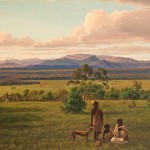
A hidden story: Eugene von Guérard’s Mr John King’s station, 1861 Ruth Pullin With the closing of the National Gallery of Victoria’s touring exhibition Eugene von Guérard: nature revealed in Canberra in July of this year it is timely to reconsider rarely seen works in the light of the close analysis made possible by the exhibition. The enigmatic Mr John King’s station 1861 (Fig. 1), not seen in Australia since 1980 and now returned to its private owners in the UK, is a work that, with its inherent ambiguities and seemingly unresolvable questions, invites renewed attention. Nothing is quite as it seems in Mr John King’s station. Conceived within a compositional and ideological framework derived from the classical European landscape tradition the painting appears to endorse the values and the social and economic concerns of the European landowner. But from…
Lecture | Sandy Nairne ‘Art Theft and the Case of the Stolen Turners’
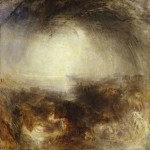
Art Theft and the Case of the Stolen Turners In 1994 two paintings by J.M.W Turner were stolen from a public gallery in Frankfurt while on loan from the Tate in London. Sandy Nairne will speak on the complex story of the theft including the return of the pictures in 2002. Sandy Nairne is the Director of the National Portrait Gallery in London. Date: Tuesday 2nd October, 6 for 6.30pm Venue: Clemenger BBDO Auditorium (enter North Entrance via Arts Centre forecourt), Information and Bookings: Ph 8662 1555, 10am–5pm daily, Code P12146. Cost: $25 A / $20 M / $22 C (includes a glass of sparkling on arrival).
